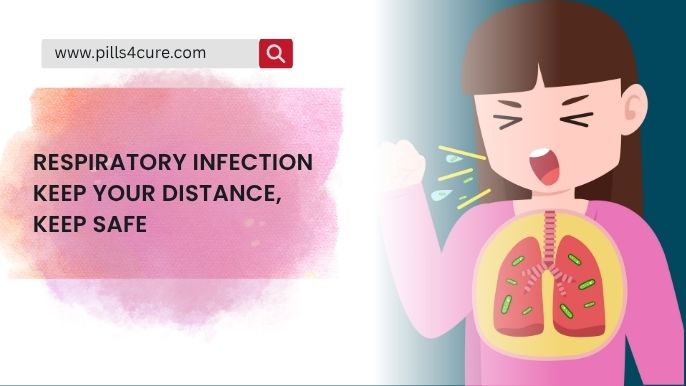Respiratory infections impact millions of Americans each year, ranging from the sniffles of a mild cold to life-threatening pneumonia that demands immediate hospital care. Recognizing the different types of respiratory infections and knowing how to respond can make all the difference in protecting your health.
An infection in the respiratory system can strike anywhere along your airway, from your nasal passages and throat to the deepest parts of your lungs. When this happens, your body’s ability to breathe comfortably and efficiently can be compromised, leading to symptoms that may start small but escalate quickly.
In this in-depth guide, we’ll explore the various types of respiratory infections, how to identify warning signs before they worsen, and the treatment options available to help you recover faster. For bacterial respiratory infections, a healthcare provider may prescribe antibiotics such as a ciprofloxacin pill a powerful medication used to target certain bacterial strains. However, proper diagnosis is crucial before starting any prescription, as not all respiratory infections require antibiotics.
Understanding when to seek professional care, which treatments are truly effective, and how to prevent future infections can help you stay healthy year-round. Whether you’re battling a stubborn cough, shortness of breath, or a high fever, the right knowledge can guide you toward safer, faster recovery.
Understanding Respiratory Tract Infections
Definition of Respiratory Tract Infection
A respiratory tract infection is any infection that affects the parts of the body involved in breathing. The respiratory system includes the nose, throat, voice box, windpipe, bronchi, and lungs. These infections can be caused by viruses, bacteria, or fungi, with viral infections being the most common.
Upper and Lower Respiratory Infection: The Key Difference
The respiratory system is divided into two main sections, each susceptible to different types of infections:
Upper Respiratory System: Includes the nose, sinuses, throat, and voice box Lower Respiratory System: Includes the windpipe, bronchi, and lungs
Types of Respiratory Infections
Upper Respiratory Infection
Upper respiratory infections are among the most common illnesses affecting adults and children. These infections typically affect the nose, throat, sinuses, and upper airways.
Common Types of Upper Respiratory Infections:
- Common Cold: The most frequent upper respiratory infection, usually caused by rhinoviruses
- Sinusitis: Inflammation of the sinus cavities, often following a cold
- Pharyngitis: Inflammation of the throat, commonly known as a sore throat
- Laryngitis: Inflammation of the voice box, causing hoarseness or voice loss
- Influenza: A viral infection that can affect both upper and lower respiratory systems
Symptoms of Upper Respiratory Infection:
- Runny or stuffy nose
- Sneezing
- Sore throat
- Mild cough
- Headache
- Low-grade fever
- Fatigue
- Post-nasal drip
Lower Respiratory Infection
Lower respiratory infections are generally more serious than upper respiratory infections and can be life-threatening if left untreated. These infections affect the airways and lungs below the voice box.
Common Types of Lower Respiratory Infections:
- Bronchitis: Inflammation of the bronchial tubes
- Pneumonia: Infection of the lung tissue
- Bronchiolitis: Inflammation of the small airways in the lungs
- Tuberculosis: A serious bacterial infection of the lungs
Symptoms of Lower Respiratory Infection:
- Deep, persistent cough (may produce phlegm)
- Chest pain or tightness
- Shortness of breath
- Wheezing
- High fever and chills
- Rapid breathing
- Fatigue and weakness
- Loss of appetite
How Do I Know If I Have a Respiratory Infection?
Recognizing the signs of a respiratory infection early can help you get appropriate treatment and prevent complications. Here are key indicators:
Mild Symptoms (Likely Upper Respiratory Infection):
- Gradual onset of cold symptoms
- Clear or white nasal discharge
- Mild throat discomfort
- Low-grade fever (under 101°F)
- Symptoms improve within 7-10 days
Severe Symptoms (Possible Lower Respiratory Infection – Seek Medical Care):
- High fever (over 101°F)
- Severe chest pain
- Difficulty breathing or shortness of breath
- Coughing up blood or thick, colored phlegm
- Symptoms worsen after initial improvement
- Persistent symptoms lasting more than 10 days
Why Do I Keep Getting Respiratory Infections?
Frequent respiratory infections can be frustrating and may indicate underlying factors that compromise your immune system or increase your exposure to pathogens.
Common Reasons for Recurring Respiratory Infections:
- Weakened Immune System
- Chronic stress
- Poor nutrition
- Lack of sleep
- Underlying health conditions
- Environmental Factors
- Exposure to allergens
- Air pollution
- Smoking or secondhand smoke
- Dry indoor air
- Lifestyle Factors
- Frequent travel
- Close contact with infected individuals
- Poor hand hygiene
- Lack of physical activity
- Medical Conditions
- Asthma
- COPD (Chronic Obstructive Pulmonary Disease)
- Diabetes
- Heart disease
Treatment Options
Over the Counter Medicine for Respiratory Infection
Many mild respiratory infections can be managed with over-the-counter medications that help relieve symptoms while your body fights the infection.
Common OTC Options:
- Pain Relievers: Acetaminophen or ibuprofen for fever and body aches
- Decongestants: Pseudoephedrine or phenylephrine for nasal congestion
- Expectorants: Guaifenesin to help loosen mucus
- Cough Suppressants: Dextromethorphan for dry, persistent cough
- Antihistamines: For runny nose and sneezing
- Throat Lozenges: For sore throat relief
When Antibiotics Are Necessary
Antibiotics are only effective against bacterial infections, not viral infections. Your healthcare provider may prescribe antibiotics if you have a confirmed bacterial respiratory infection.
Ciprofloxacin Antibiotics Uses
Ciprofloxacin is a broad-spectrum antibiotic that may be prescribed for certain bacterial respiratory infections, particularly those caused by gram-negative bacteria.
Ciprofloxacin Antibiotics Uses Include:
- Severe bacterial pneumonia
- Complicated respiratory tract infections
- Infections in patients with compromised immune systems
- Hospital-acquired pneumonia (in some cases)
Important Note: Ciprofloxacin should only be used when prescribed by a healthcare provider, as it can have serious side effects and is not appropriate for all types of respiratory infections.
Ciprofloxacin Dosage for Adults
The ciprofloxacin dosage for adults varies depending on the type and severity of infection. Always follow your healthcare provider’s instructions exactly.
Typical Ciprofloxacin Pill Dosing (for respiratory infections):
- Mild to moderate infections: 250-500 mg twice daily
- Severe infections: 500-750 mg twice daily
- Duration: Usually 7-14 days, depending on the infection
Important: Never adjust the dosage or stop taking the medication early without consulting your healthcare provider, even if you feel better.
Precautions and Prevention
General Prevention Strategies
- Practice Good Hygiene
- Wash hands frequently with soap and water
- Use alcohol-based hand sanitizer when soap isn’t available
- Avoid touching your face, especially nose and mouth
- Cover coughs and sneezes with your elbow
- Strengthen Your Immune System
- Get adequate sleep (7-9 hours nightly)
- Eat a balanced diet rich in fruits and vegetables
- Exercise regularly
- Manage stress effectively
- Stay hydrated
- Environmental Precautions
- Avoid close contact with sick individuals
- Stay home when you’re ill
- Keep indoor humidity between 30-50%
- Avoid smoking and secondhand smoke
- Get annual flu vaccinations
When to Seek Medical Care
Seek immediate medical attention if you experience:
- Difficulty breathing or shortness of breath
- Chest pain
- High fever (over 103°F)
- Coughing up blood
- Severe headache with neck stiffness
- Signs of dehydration
Contact your healthcare provider if:
- Symptoms worsen after initial improvement
- Fever persists for more than 3 days
- Cough produces thick, colored mucus
- You have underlying health conditions and develop respiratory symptoms
Home Remedies and Supportive Care
While medical treatment may be necessary for severe infections, several home remedies can help alleviate symptoms and support recovery:
- Stay Hydrated
- Drink plenty of fluids (water, herbal tea, clear broths)
- Avoid alcohol and caffeine
- Use a humidifier or breathe steam from a hot shower
- Rest and Recovery
- Get plenty of sleep
- Take time off work or school to recover
- Avoid strenuous activities
- Natural Remedies
- Honey for cough relief (not for children under 1 year)
- Salt water gargles for sore throat
- Warm compress for sinus pressure
- Chicken soup for hydration and comfort
Special Considerations
Respiratory Infections in Different Age Groups
Children: More susceptible to respiratory infections due to developing immune systems and frequent exposure to germs in schools and daycare.
Elderly: Higher risk for complications due to weakened immune systems and potential underlying health conditions.
Pregnant Women: Should consult healthcare providers before taking any medications, including over-the-counter options.
Chronic Conditions and Respiratory Infections
People with chronic conditions like asthma, COPD, diabetes, or heart disease are at higher risk for severe complications from respiratory infections and should seek medical care promptly when symptoms develop.
Frequently Asked Questions (FAQs)
Q: How long do respiratory infections typically last?
A: Upper respiratory infections usually resolve within 7-10 days, while lower respiratory infections may take 2-3 weeks or longer to fully resolve, depending on the severity and type of infection.
Q: Can I prevent respiratory infections completely?
A: While you can’t prevent all respiratory infections, following good hygiene practices, maintaining a healthy lifestyle, and getting recommended vaccinations can significantly reduce your risk.
Q: Are respiratory infections contagious?
A: Most viral and bacterial respiratory infections are contagious, typically spreading through respiratory droplets when an infected person coughs, sneezes, or talks.
Q: Can stress make me more susceptible to respiratory infections?
A: Yes, chronic stress can weaken your immune system, making you more susceptible to infections. Managing stress through relaxation techniques, exercise, and adequate sleep can help strengthen your immune defenses.
Q: Should I take antibiotics for every respiratory infection?
A: No, antibiotics only work against bacterial infections. Most respiratory infections are viral and will not respond to antibiotics. Taking unnecessary antibiotics can lead to antibiotic resistance and side effects.
Q: Can I exercise with a respiratory infection?
A: Light exercise may be okay with mild upper respiratory symptoms, but you should rest if you have fever, chest congestion, or feel unwell. Always listen to your body and consult your healthcare provider if unsure.
Q: Are there any natural ways to boost immunity against respiratory infections?
A: Yes, maintaining a healthy diet rich in vitamins C and D, getting regular exercise, adequate sleep, managing stress, and practicing good hygiene can all help support your immune system’s ability to fight off infections.







